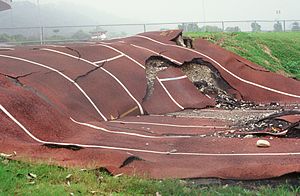Surface rupture

In seismology, surface rupture (or ground rupture, or ground displacement) is the visible offset of the ground surface when an earthquake rupture along a fault affects the Earth's surface. Surface rupture is opposed by buried rupture, where there is no displacement at ground level. This is a major risk to any structure that is built across a fault zone that may be active, in addition to any risk from ground shaking.[1] Surface rupture entails vertical or horizontal movement, on either side of a ruptured fault. Surface rupture can affect large areas of land.[2]
Lack of surface rupture
[edit]
Not every earthquake results in surface rupture, particularly for smaller and deeper earthquakes.[1] In some cases, however, the lack of surface effects is because the fault that moved does not reach the surface. For example, the 1994 Northridge earthquake had a moment magnitude of 6.7, caused major damage in the Los Angeles area, occurred at 18.2 km (11 mi) below the Earth's surface, but did not cause surface rupture, because it was a blind thrust earthquake.[3]
Where surface rupture occurs
[edit]Surface ruptures commonly occur on pre-existing faults. Only rarely are earthquakes (and surface ruptures) associated with faulting on entirely new fault structures.[4] There is shallow hypocenter, and large fracture energy on the asperities,[5] the asperity shallower than 5 kilometres (3.1 mi). Examples of such earthquakes are San Fernando earthquake, Tabas earthquake, and Chi-Chi earthquake.[6]
In surface rupture earthquakes, the large slips of land are concentrated in the shallow parts of the fault.[7] And, notably, permanent ground displacements which are measureable can be produced by shallow earthquakes, of magnitude M5 and greater.[8]
Types of surface rupture
[edit]The form that surface rupturing takes depends on two things: the nature of the material at the surface and the type of fault movement.

Effect of surface lithology
[edit]Where there are thick superficial deposits overlying the trace of the faults, the resulting surface effects are typically more discontinuous. Where there is little or no superficial deposits, the surface rupture is generally continuous, except where the earthquake rupture affects more than one fault, which can lead to complex patterns of surface faulting, such as in the 1992 Landers earthquake.[9]
Normal faulting
[edit]Surface ruptures associated with normal faults are typically simple fault scarps. Where there are significant superficial deposits, sections with more oblique faulting may form sets of en-echelon scarp segments. Antithetic faults may also develop, giving rise to surface grabens.
Reverse faulting
[edit]Reverse faulting (particularly thrust faulting) is associated with more complex surface rupture patterns since the protruding unsupported part of the hanging-wall of the fault is liable to collapse. In addition there may be surface folding and back-thrust development.
Strike-slip faulting
[edit]
Strike-slip faults are associated with dominantly horizontal movement, leading to relatively simple linear zones of surface rupture where the fault is a simple planar structure. However, many strike-slip faults are formed of overlapping segments, leading to complex zones of normal or reverse faulting depending on the nature of the overlap. Additionally, where there are thick superficial deposits, the rupture typically appears as a set of en-echelon faults.[10]
Mitigation
[edit]To retrofit a house to survive surface rupture requires engineered design by geotechnical, and structural or civil engineers. This can be quite expensive.[4]
Examples, with their extent
[edit]- 1983 Borah Peak earthquake M6.9 in Idaho, normal faulting – 34 km (21 mi)
- 1992 Landers earthquake M7.3 in San Bernardino County, California, strike-slip faulting – 80 km (50 mi),[4]
- 1999 İzmit earthquake M7.6 in Turkey, strike-slip faulting – 150 km (93 mi),[11]
- 1999 Jiji earthquake M7.6 in Taiwan, thrust faulting – 100 km (62 mi)
- 2001 Kunlun earthquake M7.8 in Tibet, strike-slip faulting – 400 km (249 mi)
- 2002 Denali earthquake M7.9 in Alaska, strike-slip faulting – 340 km (211 mi)
- 2008 Sichuan earthquake M7.9 in Sichuan, thrust faulting – 300 km (186 mi)
- 2023 Turkey–Syria earthquakes M7.8 in Turkey, strike-slip faulting – 400 km (250 mi)[12]
See also
[edit]References
[edit]- ^ a b "What is Surface Rupture". United States Geological Survey. Retrieved 2018-10-19.
- ^ "Surface rupture can be caused by vertical or horizontal displacement". 2018-10-19.
- ^ "USGS Northridge Earthquake 10th Anniversary". Retrieved 13 April 2016.
- ^ a b c "Ground Rupture & Surface Faulting – Earthquake Ground Displacement | CEA". Retrieved Jan 1, 2020.
- ^ Dalguer, Luis A.; Miyake, Hiroe; Day, Steven M.; Irikura, Kojiro. "Surface Rupturing and Buried Dynamic-Rupture Models Calibrated with Statistical Observations of Past Earthquakes". pubs.geoscienceworld.org. Retrieved 28 October 2018.
{{cite web}}: CS1 maint: multiple names: authors list (link) - ^ Wada, K.; Goto, H. "Generation Mechanism of Surface and Buried Faults Considering the Effect of Plasticity in a Shallow Crust Structure" (PDF). iitk.ac.in. Retrieved 31 October 2018.
{{cite web}}: CS1 maint: multiple names: authors list (link) - ^ "Differences in ground motion and fault rupture process between the surface and buried rupture earthquakes" (PDF). Earth Planets Space. 14 March 2004. Retrieved 26 October 2018.
- ^ "Earthquake Processes and Effects". United States Geological Survey.
- ^ Zachariesen J.; Sieh K. (1995). "The transfer of slip between two en echelon strike-slip faults: A case study from the 1992 Landers earthquake, southern California" (PDF). Journal of Geophysical Research. 100 (B8): 15, 281–15, 301. Bibcode:1995JGR...10015281Z. doi:10.1029/95JB00918. hdl:10220/8475.
- ^ Tchalenko J.S.; Ambraseys N.N. (1970). "Structural Analysis of the Dasht-e Bayaz (Iran) Earthquake Fractures". GSA Bulletin. 81 (1): 41–60. doi:10.1130/0016-7606(1970)81[41:SAOTDB]2.0.CO;2.
- ^ Reilinger, R.E.; Ergintav S.; Bürgmann R.; McClusky S.; Lenk O.; Barka A.; Gurkan O.; Hearn L.; Feigl K.L.; Cakmak R.; Aktug B.; Ozener H. & Töksoz M.N. (2000). "Coseismic and Postseismic Fault Slip for the 17 August 1999, M = 7.5, Izmit, Turkey Earthquake" (PDF). Science. 289 (5484). American Association for the Advancement of Science: 1519–1524. Bibcode:2000Sci...289.1519R. doi:10.1126/science.289.5484.1519. PMID 10968782.
- ^ "Yer kabuğundaki kayma 7 metre 30 santimetreye kadar çıktı" [The slip in the Earth's crust was up to 7 meters 30 centimeters] (in Turkish). Gazete Zebra. 15 February 2023. Retrieved 15 February 2023.
